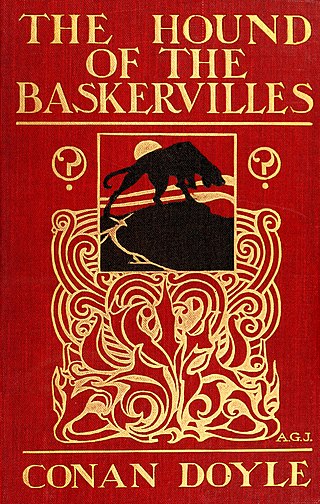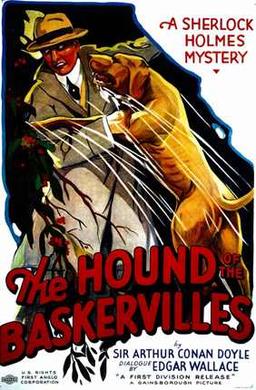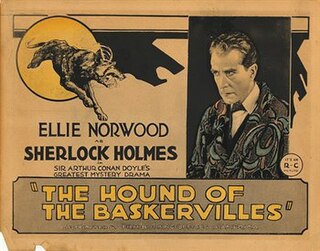
Dartmoor is an upland area in southern Devon, South West England. The moorland and surrounding land has been protected by National Park status since 1951. Dartmoor National Park covers 954 km2 (368 sq mi).
Princetown is a village located within Dartmoor national park in the English county of Devon. It is the principal settlement of the civil parish of Dartmoor Forest.

The Hound of the Baskervilles is the third of the four crime novels by British writer Arthur Conan Doyle featuring the detective Sherlock Holmes. Originally serialised in The Strand Magazine from August 1901 to April 1902, it is set largely in Dartmoor, Devon, in England's West Country and follows Holmes and Watson investigating the legend of a fearsome, diabolical hound of supernatural origin. This was the first appearance of Holmes since his apparent death in "The Final Problem", and the success of The Hound of the Baskervilles led to the character's eventual revival.

Buckfastleigh is a market town and civil parish in Devon, England situated beside the Devon Expressway (A38) at the edge of the Dartmoor National Park. It is part of Teignbridge and, for ecclesiastical purposes, lies within the Totnes Deanery. It is 18 miles east-northeast of Plymouth, 20 miles southwest of Exeter and has a population of 3,661. It is a centre of tourism and is home to Buckfast Abbey, the South Devon Railway, the Buckfastleigh Butterfly Farm and Otter Sanctuary, the Tomb of Squire Richard Cabell and The Valiant Soldier.

Jay's Grave is supposedly the last resting place of a suicide victim who is thought to have died in the late 18th century. It has become a well-known landmark on Dartmoor, Devon, in South-West England, and is the subject of local folklore, and several ghost stories.

Fox Tor is a relatively minor tor on Dartmoor in the county of Devon, England.

Hound Tor is a tor on Dartmoor, Devon, England and is a good example of a heavily weathered granite outcrop. It is easily accessible, situated within a few minutes from the B3387 between Bovey Tracey and Widecombe-in-the-Moor.

The Hound of the Baskervilles is a 1959 British gothic mystery film directed by Terence Fisher and produced by Hammer Film Productions. It is based on the 1902 novel of the same title by Sir Arthur Conan Doyle. It stars Peter Cushing as Sherlock Holmes, Sir Christopher Lee as Sir Henry Baskerville and André Morell as Doctor Watson. It is the first film adaptation of the novel to be filmed in colour.

The Hound of the Baskervilles is a 1939 American gothic mystery film based on the 1902 Sherlock Holmes novel of the same name by Sir Arthur Conan Doyle. Directed by Sidney Lanfield, the film stars Basil Rathbone as Sherlock Holmes and Nigel Bruce as Dr. John Watson. Released by 20th Century Fox, it is the first of fourteen Sherlock Holmes films produced between 1939 and 1946 starring Rathbone and Bruce.
The Hound of the Baskervilles is a 2002 television adaptation of Sir Arthur Conan Doyle's 1902 novel of the same name.

The black dog is a supernatural, spectral, or demonic hellhound originating from English folklore, and also present in folklore throughout Europe and the Americas. It is usually unnaturally large with glowing red or yellow eyes, is often connected with the Devil, and is sometimes an omen of death. It is sometimes associated with electrical storms, and also with crossroads, barrows, places of execution and ancient pathways.

Dewerstone is the site of an Iron Age Hill fort on a rocky promontory overlooking the River Plym on the South West edge of Dartmoor to the North of Plympton in Devon. The fort consists of ramparts to the Northern side of the promontory at approx 210 Metres above Sea Level.

Bertram Fletcher Robinson was an English sportsman, journalist, editor, author and Liberal Unionist Party activist. During his life-time, he wrote at least three hundred items, including a series of short stories that feature a detective called 'Addington Peace'. Following his untimely death at the age of just 36 years, speculation grew that Robinson was the victim of a curse bestowed upon him by an Egyptian antiquity at the British Museum, which he had researched whilst working as a journalist for a British newspaper. However, Robinson is perhaps best remembered for his literary collaborations with his friends and fellow Crimes Club members, Arthur Conan Doyle, P. G. Wodehouse and Max Pemberton.

The Hound of the Baskervilles is a 1983 British made-for-television mystery thriller film directed by Douglas Hickox, starring Ian Richardson as Sherlock Holmes and Donald Churchill as Dr. John H. Watson. It is based on Arthur Conan Doyle's 1902 novel The Hound of the Baskervilles.

The Hound of the Baskervilles is a 1932 British mystery film directed by Gareth Gundrey and starring John Stuart, Robert Rendel and Frederick Lloyd. It is based on the 1902 novel The Hound of the Baskervilles by Arthur Conan Doyle, in which Sherlock Holmes is called in to investigate a suspicious death on Dartmoor. It was made by Gainsborough Pictures. The screenplay was written by Edgar Wallace.

The Hound of the Baskervilles is a 1921 British silent mystery film directed by Maurice Elvey and starring Eille Norwood, Catina Campbell and Rex McDougall. It is based on the 1902 Sherlock Holmes novel The Hound of the Baskervilles by Arthur Conan Doyle. It was made by Stoll Pictures, Britain's largest film company at the time. It was the first British film adaptation of the famous novel.

Sir Edmund Fowell, 1st Baronet of Fowelscombe in the parish of Ugborough in Devon, was a Member of Parliament for Ashburton in Devon from 1640 to 1648.

Fowelscombe is a historic manor in the parish of Ugborough in Devon, England. The large ancient manor house known as Fowelscombe House survives only as an ivy-covered "romantic ruin" overgrown by trees and nettles, situated 1 mile south-east of the village of Ugborough. The ruins are a Grade II listed building.

"The Hounds of Baskerville" is the second episode of the second series of the BBC crime drama series Sherlock, which follows the modern-day adventures of Sherlock Holmes, and was first broadcast by BBC One on 8 January 2012. It was written by co-creator Mark Gatiss, who also portrays Mycroft Holmes, Sherlock's brother in the series, and was directed by Paul McGuigan. The episode is a contemporary adaptation of The Hound of the Baskervilles, one of Sir Arthur Conan Doyle's most famous works.

The Hound of the Baskervilles is a 1929 German silent mystery film directed by Richard Oswald and is an adaptation of the 1902 Sherlock Holmes novel The Hound of the Baskervilles by Arthur Conan Doyle. The film stars Carlyle Blackwell as Sherlock Holmes and George Seroff as Dr. Watson, with Betty Bird, Alexander Murski, and Livio Pavanelli in supporting roles. It tells the story of Holmes (Blackwell) investigating the mysterious death of Sir Charles Baskerville, believed to be caused by a supernatural hound haunting the Baskerville family. This was the last Sherlock Holmes adaptation of the silent film era.



















